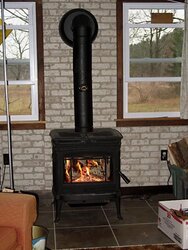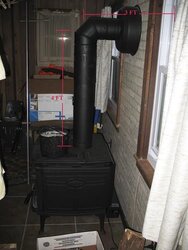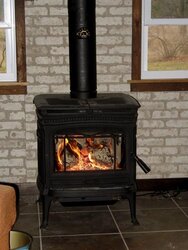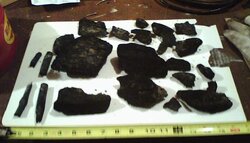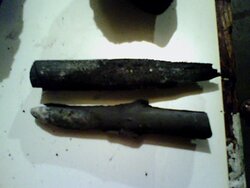We replaced our inefficient and smoky woodstove at the cabin with a Alderlea T5 early November. So far we are not impressed and almost wish we could send it back.
Brochure says 70% effic. It is more like 35% and not the 72,000BTU but more like 35,000. The logs load in end wise front to back and burn only the first 6" at a time. The burn eventually gets to the back but only when the front goes to ember stage.
The glass is constantly coated with black soot on edges.
Embers never burn down to a grey ash, in fact at the back of firebox the wood remains in a cinder form. A hard black ember that may be warm in middle but not burning unless you really pound it with a poker letting the sparks fly in the process.
When installed the installer stated we had very good dry wood since he tested several pieces for moisture. He threw in a bunch of pressed wood for starters along with our wood to let the fire rip. He then told family how to use fireplace, temps such as getting it up to 1000 degrees and then giving a gage that went up to 800. Bricks should change to natural color before turning damper down, etc.
The next day we went to check on excessive level of embers and found huge hard black pieces of warm but intact pressed wood under embers. We even found kindling still intact under the embers.see cinders picture.
The company then said we need to cure the iron and bricks of the moisture that is inside of them. (I should of asked them if that is why cars rust but did not think of it in time).
To do this we need to before each season constantly burn at HI wide open for 24 hours or more a full load of wood at all times. I know about curing the stove of paint and dust etc and it smells for a bit, but that sounded ridiculous. Besides It was only 40 degrees we needed fans and all windows open to stay cool. They said it was NOT designed for mild weather and did not draft as well. Too bad for you guys heating your homes with this stove!
After hi heat cycle we had a depth of 5 inches of 1"-4" embers and could not put wood in and burned our ash bucket, stove interior was turning red. Logs burned on top with a full load but when we turned down the damper finally,logs still burned at front only. We were told to keep burning at HI, and to stir and break up the larger embers. This caused dangerous sparks to fly out the door! the lady said she would call us back, she NEVER did.
It also takes long time for new kindling to even start up, it just glows & smokes first.
The chimney only got up to about 350 degrees 18 inches above the stove. The chimney specs are a 6" double wall pipe extends vertical about 4ft up from stove, then back horizontal about 3ft. It fits into the exterior chimney which is of cinder block with a 7" square steel insert. The chimney from base of fireplace to top is 16'9"
With only half the heat output we surely won't get overheated but in very cold weather we won't get warm either in back bedrooms.
The concealed cook top should remain that way-concealed, it does not even boil water at less than 200 degrees
We were advised we do not need a cold air supply, but I think it would help? No air is getting to rear of firebox!
Any ideas or suggestions besides returning it which is not possible.
My fireplace at our house is a dream compared to this monstrosity.
IMG 2110 IS FRONT VIEW
Image 2121 is side view
Image cinders is sample of cinders found after 1 day large pieces would not break apart with a poker Sticks on left side is the unburned kindling which was found under the embers from rear of firebox.
img 2111: showing wide open windows on 30 degree day because we had to "cure" for 30 hours the water out of the steel, also shows smoky glass despite hot firebox & 5" of embers. Even with 5" of embers reloads took a match to light kindling.
Brochure says 70% effic. It is more like 35% and not the 72,000BTU but more like 35,000. The logs load in end wise front to back and burn only the first 6" at a time. The burn eventually gets to the back but only when the front goes to ember stage.
The glass is constantly coated with black soot on edges.
Embers never burn down to a grey ash, in fact at the back of firebox the wood remains in a cinder form. A hard black ember that may be warm in middle but not burning unless you really pound it with a poker letting the sparks fly in the process.
When installed the installer stated we had very good dry wood since he tested several pieces for moisture. He threw in a bunch of pressed wood for starters along with our wood to let the fire rip. He then told family how to use fireplace, temps such as getting it up to 1000 degrees and then giving a gage that went up to 800. Bricks should change to natural color before turning damper down, etc.
The next day we went to check on excessive level of embers and found huge hard black pieces of warm but intact pressed wood under embers. We even found kindling still intact under the embers.see cinders picture.
The company then said we need to cure the iron and bricks of the moisture that is inside of them. (I should of asked them if that is why cars rust but did not think of it in time).
To do this we need to before each season constantly burn at HI wide open for 24 hours or more a full load of wood at all times. I know about curing the stove of paint and dust etc and it smells for a bit, but that sounded ridiculous. Besides It was only 40 degrees we needed fans and all windows open to stay cool. They said it was NOT designed for mild weather and did not draft as well. Too bad for you guys heating your homes with this stove!
After hi heat cycle we had a depth of 5 inches of 1"-4" embers and could not put wood in and burned our ash bucket, stove interior was turning red. Logs burned on top with a full load but when we turned down the damper finally,logs still burned at front only. We were told to keep burning at HI, and to stir and break up the larger embers. This caused dangerous sparks to fly out the door! the lady said she would call us back, she NEVER did.
It also takes long time for new kindling to even start up, it just glows & smokes first.
The chimney only got up to about 350 degrees 18 inches above the stove. The chimney specs are a 6" double wall pipe extends vertical about 4ft up from stove, then back horizontal about 3ft. It fits into the exterior chimney which is of cinder block with a 7" square steel insert. The chimney from base of fireplace to top is 16'9"
With only half the heat output we surely won't get overheated but in very cold weather we won't get warm either in back bedrooms.
The concealed cook top should remain that way-concealed, it does not even boil water at less than 200 degrees
We were advised we do not need a cold air supply, but I think it would help? No air is getting to rear of firebox!
Any ideas or suggestions besides returning it which is not possible.
My fireplace at our house is a dream compared to this monstrosity.
IMG 2110 IS FRONT VIEW
Image 2121 is side view
Image cinders is sample of cinders found after 1 day large pieces would not break apart with a poker Sticks on left side is the unburned kindling which was found under the embers from rear of firebox.
img 2111: showing wide open windows on 30 degree day because we had to "cure" for 30 hours the water out of the steel, also shows smoky glass despite hot firebox & 5" of embers. Even with 5" of embers reloads took a match to light kindling.


